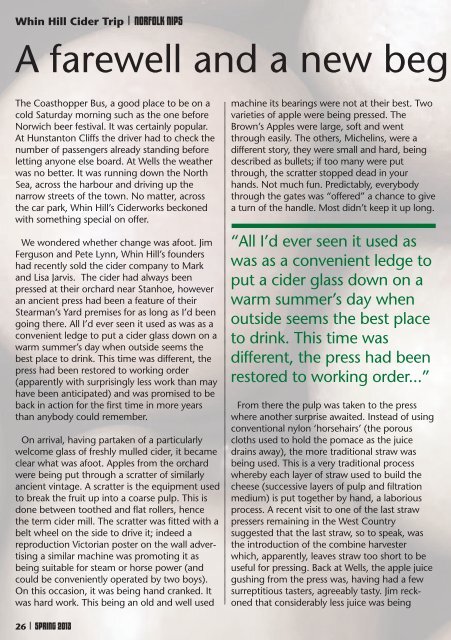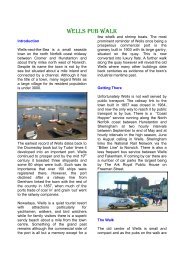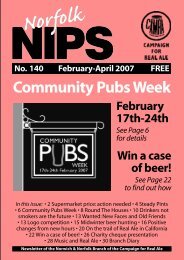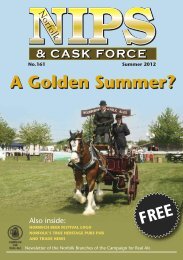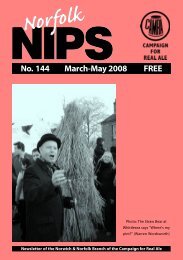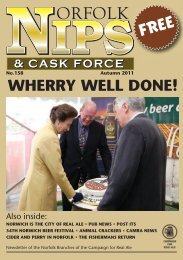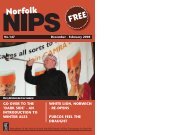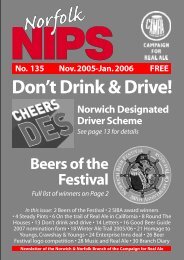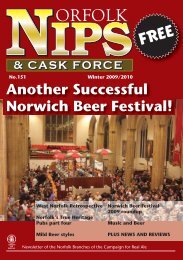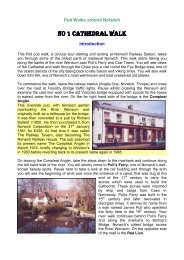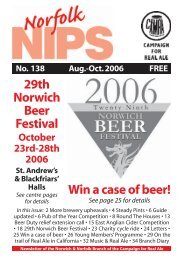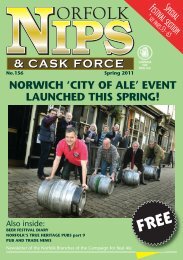Welcome to Norwich. - Norwich and Norfolk CAMRA
Welcome to Norwich. - Norwich and Norfolk CAMRA
Welcome to Norwich. - Norwich and Norfolk CAMRA
You also want an ePaper? Increase the reach of your titles
YUMPU automatically turns print PDFs into web optimized ePapers that Google loves.
Whin Hill Cider Trip | NORFOLK NIPS<br />
A farewell <strong>and</strong> a new beg<br />
The Coasthopper Bus, a good place <strong>to</strong> be on a<br />
cold Saturday morning such as the one before<br />
<strong>Norwich</strong> beer festival. It was certainly popular.<br />
At Hunstan<strong>to</strong>n Cliffs the driver had <strong>to</strong> check the<br />
number of passengers already st<strong>and</strong>ing before<br />
letting anyone else board. At Wells the weather<br />
was no better. It was running down the North<br />
Sea, across the harbour <strong>and</strong> driving up the<br />
narrow streets of the <strong>to</strong>wn. No matter, across<br />
the car park, Whin Hill’s Ciderworks beckoned<br />
with something special on offer.<br />
We wondered whether change was afoot. Jim<br />
Ferguson <strong>and</strong> Pete Lynn, Whin Hill’s founders<br />
had recently sold the cider company <strong>to</strong> Mark<br />
<strong>and</strong> Lisa Jarvis. The cider had always been<br />
pressed at their orchard near Stanhoe, however<br />
an ancient press had been a feature of their<br />
Stearman’s Yard premises for as long as I’d been<br />
going there. All I’d ever seen it used as was as a<br />
convenient ledge <strong>to</strong> put a cider glass down on a<br />
warm summer’s day when outside seems the<br />
best place <strong>to</strong> drink. This time was different, the<br />
press had been res<strong>to</strong>red <strong>to</strong> working order<br />
(apparently with surprisingly less work than may<br />
have been anticipated) <strong>and</strong> was promised <strong>to</strong> be<br />
back in action for the first time in more years<br />
than anybody could remember.<br />
On arrival, having partaken of a particularly<br />
welcome glass of freshly mulled cider, it became<br />
clear what was afoot. Apples from the orchard<br />
were being put through a scratter of similarly<br />
ancient vintage. A scratter is the equipment used<br />
<strong>to</strong> break the fruit up in<strong>to</strong> a coarse pulp. This is<br />
done between <strong>to</strong>othed <strong>and</strong> flat rollers, hence<br />
the term cider mill. The scratter was fitted with a<br />
belt wheel on the side <strong>to</strong> drive it; indeed a<br />
reproduction Vic<strong>to</strong>rian poster on the wall advertising<br />
a similar machine was promoting it as<br />
being suitable for steam or horse power (<strong>and</strong><br />
could be conveniently operated by two boys).<br />
On this occasion, it was being h<strong>and</strong> cranked. It<br />
was hard work. This being an old <strong>and</strong> well used<br />
machine its bearings were not at their best. Two<br />
varieties of apple were being pressed. The<br />
Brown’s Apples were large, soft <strong>and</strong> went<br />
through easily. The others, Michelins, were a<br />
different s<strong>to</strong>ry, they were small <strong>and</strong> hard, being<br />
described as bullets; if <strong>to</strong>o many were put<br />
through, the scratter s<strong>to</strong>pped dead in your<br />
h<strong>and</strong>s. Not much fun. Predictably, everybody<br />
through the gates was “offered” a chance <strong>to</strong> give<br />
a turn of the h<strong>and</strong>le. Most didn’t keep it up long.<br />
“All I’d ever seen it used as<br />
was as a convenient ledge <strong>to</strong><br />
put a cider glass down on a<br />
warm summer’s day when<br />
outside seems the best place<br />
<strong>to</strong> drink. This time was<br />
different, the press had been<br />
res<strong>to</strong>red <strong>to</strong> working order...”<br />
From there the pulp was taken <strong>to</strong> the press<br />
where another surprise awaited. Instead of using<br />
conventional nylon ‘horsehairs’ (the porous<br />
cloths used <strong>to</strong> hold the pomace as the juice<br />
drains away), the more traditional straw was<br />
being used. This is a very traditional process<br />
whereby each layer of straw used <strong>to</strong> build the<br />
cheese (successive layers of pulp <strong>and</strong> filtration<br />
medium) is put <strong>to</strong>gether by h<strong>and</strong>, a laborious<br />
process. A recent visit <strong>to</strong> one of the last straw<br />
pressers remaining in the West Country<br />
suggested that the last straw, so <strong>to</strong> speak, was<br />
the introduction of the combine harvester<br />
which, apparently, leaves straw <strong>to</strong>o short <strong>to</strong> be<br />
useful for pressing. Back at Wells, the apple juice<br />
gushing from the press was, having had a few<br />
surreptitious tasters, agreeably tasty. Jim reckoned<br />
that considerably less juice was being<br />
26 | SPRING 2013


